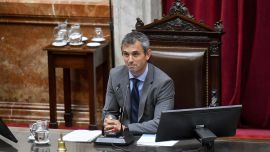The number of people who went missing in Argentina during the 1976-1983 military dictatorship has motivated debates revived since Javier Milei came to power, in particular where the number of 30,000 is concerned – a figure which became symbolic in the years when the crimes of the dictatorship were being denounced but which was never established with precision.
Emilio Crenzel, with an extensive track record as a researcher of such problems, is the author of a detailed work published last February in Latin American Research Review ('¿Cuántos son los desaparecidos y cuantas las víctimas de la desaparición forzada en la Argentina? Debates político-memoriales e investigación académica,' https://bit.ly/cuantosson), in which he traces the history of numbering the victims, proposing that this issue be rigorously tackled. His work is enlightening and perhaps a valuable starting-point for getting on top of this debate at the heart of Argentine society – at least for those who approach this discussion in good faith and not with superficial chicanery (like the current president) or to ratify ideological biases. The objection might be raised that these are not times of good faith but nothing is more valuable in any discussion than good arguments.
Crenzel explains that the number of 30,000 disappeared has become canon law, although his study shows this number to be neither arbitrary nor capricious but emerging from a series of data elaborated over many years since the initial days of the dictatorship. Since the first lists the organisations have denounced various estimates from a few thousand names to numbers well over 30,000.
Following the return of democracy the CONADEP (Comisión Nacional sobre la Desaparición de Personas) truth commission created by the Raúl Alfonsín government (1983-1989) registered a number close to 9,000 cases. In the 1990s, amid 20 pardons decreed by then-president Carlos Menem to guarantee the impunity of those most responsible for the illegal repression, different groups and associations of civil society elaborated their own figures with all the difficulties implied by the grudging attitude of the state in those times. Only in this century has the state – especially the Néstor Kirchner Presidency (2003-2007) – proposed new attempts at clarification like RUVTE (Registro Único de Víctimas del Terrorismo de Estado).
The resurgence of denialism of the dictatorship’s crimes (initiated “officially” during the Presidency of Mauricio Macri, who revived talk of a “dirty war” and spoke of the “human rights scam”) was boosted by Javier Milei who relativised those crimes, both before and above all since his arrival in government.
The number deployed by those who surreptitiously deny (or worse still, justify) the atrocities of state terrorism is the register of those who never returned – i.e. those who did not survive and who were identified as fatal victims. But the number of people who were victims in the different variants (those who went missing, those who were illegally arrested, those who were tortured and the baby-snatching) totals more than 30,000.
Emilio Crenzel’s work gives the history of the missing and victims of forced disappearance as elaborated by various social segments, proposing an academic approximation of the issue. He understands the figures in a double dimension – firstly as the fruit of the elaborate processing of what is known about the disappearances in a clandestine context, but also as the expression of social struggles for the memory of human rights violations during that period of national history.
Crenzel has a respected track record as a specialist in this issue. With undergraduate and doctoral degrees in sociology from the University of Buenos Aires (UBA), he is a researcher with the Conicet national research council, a UBS sociology professor and the author of numerous works on the issue, among them, La historia política del Nunca Más. La memoria de las desapariciones en la Argentina, published by Siglo XXI and now in its third edition.
A key aspect
Crenzel reconstructs the difficulties in elaborating the data from the dictatorship to the present, showing the divergence between the denunciations and the fragmentation of state agencies to be among the reasons for the diversity of figures and emphasising a key aspect as the differentiation between those who continue missing and those who have passed through the system of forced disappearances. That singular outlook makes it more complex to quantify the victims of this crime.
He highlights that already in the first days of 1976, the writer Haroldo Conti in a letter to the editor of the Cuban magazine Casa de las Américas commented that a military friend of his had just informed him confidentially that “a bloodthirsty coup is expected for March” and that “the intelligence services are calculating 30,000 dead.” Crenzel says that there is no evidence as to the origin of this iconic figure but if there were, it would demonstrate that it emerged prior to the coup and was pronounced for the first time by its perpetrators.
Crenzel’s revision is exhaustive, running over different sources and numbers. From Amnesty International estimating the number of missing at between 3,000 and 30,000 in late 1977 and suggesting an average of 15,000 coinciding with that of Rodolfo Walsh in his famous “letter” to the junta in the year of the coup. And from the APDH (Asamblea Permanente por los Derechos Humanos) to Tex Harris at the United States Embassy (who in 1977 drew up a list of 7,500 missing people which was handed to junta chief Jorge Videla on his US visit) passing through CADHU (Comisión Argentina de Derechos Humanos), the Argentine Information and Service Center of New York, the Information Bureau of Washington DC (whose 1977 report estimated 20,000) and the presentation of Rodolfo Mattarollo to the United Nations Human Rights Council suggesting 20,000-30,000 victims of forced disappearances.
In 1978 a list of 2,536 names was published in La Prensa newspaper with the Interior Ministry objecting to 87 of them (implicitly recognising the remainder). That same year Emilio Mignone of the APDH estimated the disappearances at 20,000-30,000 with 10,000 murdered, while the US State Department numbered the cases at 15,000. In 1978 the Chilean intelligence agent Enrique Arancibia Clavel reported that according to his Argentine colleagues, 22,000 people had gone missing since 1975. The discussion over the numbers divided families which argued in public over the scale of the crimes.
Different questions
What is now the true number of detained-disappeared in Argentina and how many were the victims of forced disappearances? Crenzel shows that these are two different questions with the answers to both still uncertain and perhaps this uncertainty can never be totally rectified.
That uncertainty also extends to the number of people who were imprisoned, exiled, tortured, fired and “insiled” (i.e exiled in their own country). Determining those numbers presents difficulties due to the clandestine nature of the crimes, the refusal of the perpetrators to hand over information and the impossibility of finding the lists which were in their power.
The human rights organisations denounced the existence of some 12,000 political prisoners while CONADEP registered 8,625 in 1984. The number of political exiles is difficult to estimate – the vast majority did not leave the country via the UN High Commissioner for Refugees numbered them at 30,000-50,000 while other estimates during the dictatorship were around two million.
The iconic figure
Crenzel explains, after examining the registers in minute detail, that the disappeared comprehend, apart from the people who stay missing, thousands of survivors, another figure of people killed outright and thousands of political prisoners who previously vanished from sight as well as an uncertain number of missing people and survivors who have not been registered.
“That would add up to approximately the emblematic figure,” he emphasises, “which is perhaps why ‘30,000’ has such potency, evoking the condition of tens of thousands of persons in those times when their fate was unknown.”
The exact number of disappeared and those who went missing can never be established, concludes Crenzel, pointing out with austerity the shades of debate over the number. While some underestimate the importance of establishing these figures from a moral perspective (“because life is unique and global figures dehumanise the victims,” they affirm), social scientists do not doubt the importance of giving social processes a quantitative dimension: “The figures create a social representation of the crimes, establishing their political relevance.”
One central point for understanding Crenzel’s work is the fact that the persons who remain missing to this day are not the equivalent of the total victims of forced disappearance. This latter universe also includes over 3,000 survivors of clandestine detention centres, according to the RUVTE in 2015, but whose number has increased since the renewal of criminal trials.
Summing up the exhaustive revision of his work, the census of the persons who went missing would read as follows:
– The 7,018 persons who remain missing (according to the RUVTE register for 2015);
– The 3,432 survivors (also a RUVTE figure);
– Most of the 783 cases denounced to the CONADEP which continue to be evaluated;
– Some of the 1,613 killed outright;
– An important fraction of the 8,625 political prisoners who were previously classified as missing.
To that number (over 21,000 cases) should be added the disappearances which were not denounced (nobody knows how many they are) and especially the unreported survivors who, according to the estimates of RUVTE officials, would treble the number of people who remain missing. That total could comfortably top the “canon law” figure by several thousand.
The arithmetic of cruelty
Last March 24 the El Gato y La Caja group published in Instagram a scientific study which they (very appropriately) entitled “Aritmética de la crueldad.” There they summed up some available data which by different paths arrived at figures not only close to 30,000 but palpably superior, concluding that “30,000 is not an inflated figure but, on the contrary, seems to fall short.” They show, for example, that the officially recognised clandestine detention and torture centres were around 800. If 40 people had passed through each one of them, the multiplication would top 30,000.
It might be added that the victims are always far more than those who were counted up and those who did not return. Or was Carmen Argibay, the Supreme Court’s first female justice who died 10 years ago and whose whereabouts were unknown during almost the whole year of 1976, not a surviving victim? Or Perfil's director Jorge Fontevecchia, who was abducted and disappeared from sight in 1979? There are thousands and perhaps hundreds of thousands like them who do not figure in any official list for the simple reason that they survived.
The victims are many more than those who suffered state terror in the flesh while the decision to place limits on the count is arbitrary. Or were not all those suffering the absence of a loved one victims? What mother or father could fail to identify, upon knowing her story, with the abysmal grief and inconsolable anguish which froze the smile of a small town mother like Luisa Cecchini de Zaragoza, who after burying her elder son (Chilo, murdered by the Triple A paramilitary) was condemned to be forever ignorant of the fate of her younger son (Neco, abducted by the dictatorship)? One could continue pushing up the calculation, multiplying the iconic figure by several times 30,000.
Such calculations are necessary. Assenting to all the necessary calculations while reviewing the sources, the archives and the numerical history, as Crenzel does, is not “playing into the hands” of the denialists. On the contrary, it is necessary to respond to their arguments and refute their arithmetic of cruelty, precisely because those who occupy the top posts in our mistreated republic say so from up there.
It is necessary to do so because the data and the facts have the virtue of imposing themselves over opinions but require people to put them on the table. There is no other way to impose the truth. It cannot do so by itself.
Cognitive biases exist, of course. The intuition of Francis Bacon had already discovered them with his “idols” three and a half centuries before Daniel Kahneman and Amos Tversky baptised them as “cognitive biases” in 1972. But people of good faith and goodwill, even when already impregnated by a perverse preaching, can modify their opinions if confronted by other opinions well founded in data and verifiable information.
That is why the work of Emilio Crenzel is so important.
Signals of horror
There is also one other element which nobody should set aside. Before the elections, one horrendous detail appearing in the electoral platform of La Libertad Avanza was repeated mention of the national security doctrine (https://bit.ly/docseguridad). It was a clear and unmistakable sign of the debates which the Javier Milei government would seek to revive.
Another signal was supplied by the aforementioned group El Gato y la Caja when they noted that behind every authoritarian government there lies an economic plan which seeks to impose, always in favour of the élites, the “planned misery” of which Rodolfo Walsh spoke. That spells disciplining a society via terror, exorcising dissidents and dismantling the opposition.
If the government is reviving this discussion, it is because it is pursuing other ends. Arguing the arithmetic of cruelty is not in vain. It is a signal which should not be overlooked but it is no use responding with other signals or dogmatic phrases. The response should be data and well grounded opinions so that the truth can reach people of good faith who (this writer at least considers) continue to constitute the majority of Argentine society.
* Américo Schvartzman is a journalist, philosopher and member of the cooperative of journalists, El Miércoles Comunicación y Cultura, in Entre Ríos, and of the environmental ethics group of SAdAF (Sociedad Argentina de Análisis Filosófico).
related news
by Américo Schvartzman*


























Comments